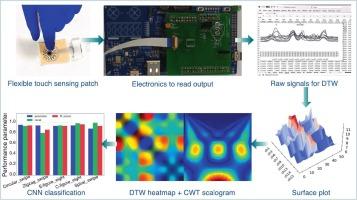FlexSwipe: Flexible multi-element touch sensing system and temporal shape analysis for complex swipe recognition
IF 5.6
2区 工程技术
Q1 ENGINEERING, MULTIDISCIPLINARY
引用次数: 0
Abstract
Advances in complex gesture recognition rely heavily on precise touch sensing patches that accurately interpret user movements. However, reliably distinguishing complex gestures that share similar shapes, durations or pressure variations remain challenging and requires robust technological approaches. This study presents a complete framework that combines a custom-built, flexible, multi-element touch sensing patch with machine learning (ML) to detect and classify complex gestures such as “circular_swipe”, “zigzag_swipe”, “figure_eight”, and “spiral_swipe”. High resolution time-series signals were captured from multiple sensing elements by executing slow and fast swipe gestures. Dynamic Time Warping (DTW) was used for analyzing shape similarity and heatmap generation, while Continues Wavelet Transform (CWT) was applied for time–frequency feature extraction. DTW-heatmaps and CWT-scalograms were used as input features for ML models to learn gesture-specific energy patterns. While traditional ML algorithms performed reasonably well, Convolutional Neural Network (CNN) demonstrated a more robust capability for dynamic gesture classification. Confusion matrices revealed that the system achieved an accuracy of 92 % and 88 % for slow and fast swipe gestures, respectively. Our work demonstrates the potential of combining signal shape analysis with deep learning for advancing touch-based assistive technologies that enable low-effort, intuitive control for individuals with limited mobility.

FlexSwipe:灵活的多元素触摸传感系统和复杂滑动识别的时间形状分析
复杂手势识别的进步在很大程度上依赖于精确的触摸传感补丁,以准确地解释用户的动作。然而,可靠地区分具有相似形状、持续时间或压力变化的复杂手势仍然具有挑战性,需要强大的技术方法。本研究提出了一个完整的框架,将定制的、灵活的、多元素的触摸传感贴片与机器学习(ML)相结合,以检测和分类复杂的手势,如“circular_swipe”、“zigzag_swipe”、“figure_eight”和“spiral_swipe”。通过执行慢速和快速滑动手势,从多个传感元件捕获高分辨率时间序列信号。采用动态时间变换(DTW)进行形状相似性分析和热图生成,采用连续小波变换(CWT)进行时频特征提取。dtw -热图和cwt -尺度图被用作ML模型的输入特征来学习特定于手势的能量模式。虽然传统的机器学习算法表现相当好,但卷积神经网络(CNN)在动态手势分类方面表现出更强大的能力。混淆矩阵显示,该系统对慢速和快速滑动手势的准确率分别为92%和88%。我们的工作展示了将信号形状分析与深度学习相结合的潜力,以推进基于触摸的辅助技术,为行动不便的个人提供低成本、直观的控制。
本文章由计算机程序翻译,如有差异,请以英文原文为准。
求助全文
约1分钟内获得全文
求助全文
来源期刊

Measurement
工程技术-工程:综合
CiteScore
10.20
自引率
12.50%
发文量
1589
审稿时长
12.1 months
期刊介绍:
Contributions are invited on novel achievements in all fields of measurement and instrumentation science and technology. Authors are encouraged to submit novel material, whose ultimate goal is an advancement in the state of the art of: measurement and metrology fundamentals, sensors, measurement instruments, measurement and estimation techniques, measurement data processing and fusion algorithms, evaluation procedures and methodologies for plants and industrial processes, performance analysis of systems, processes and algorithms, mathematical models for measurement-oriented purposes, distributed measurement systems in a connected world.
 求助内容:
求助内容: 应助结果提醒方式:
应助结果提醒方式:


